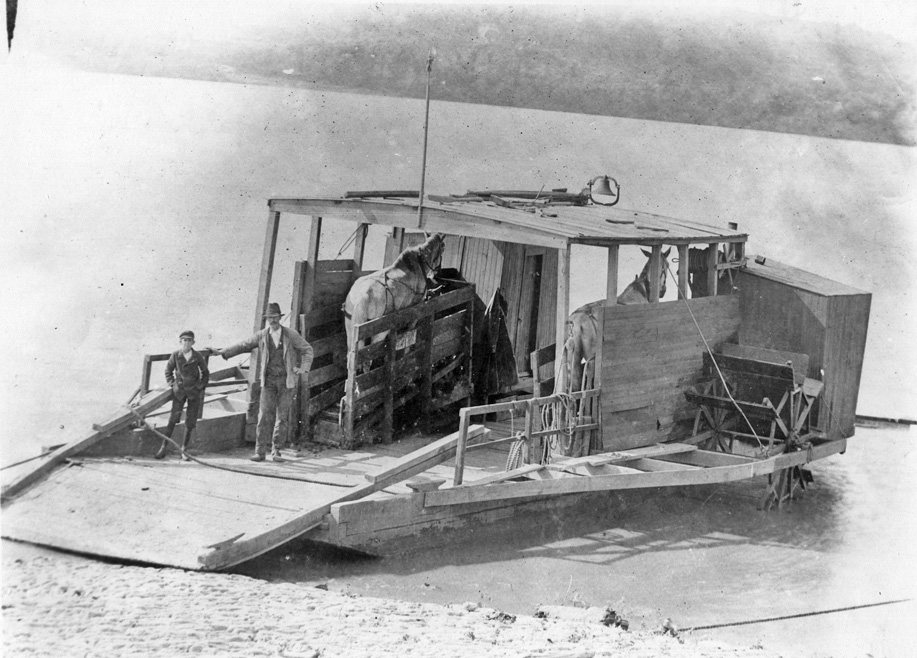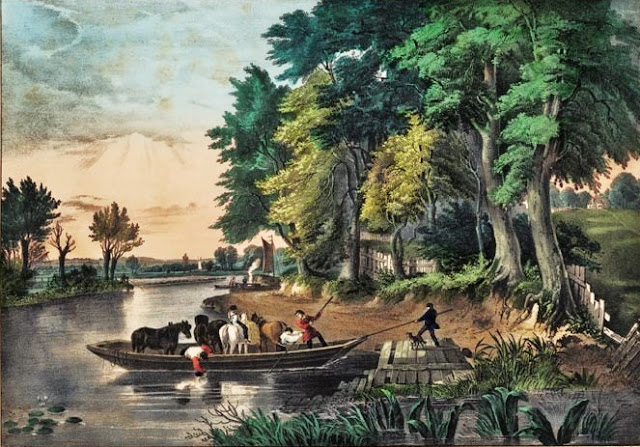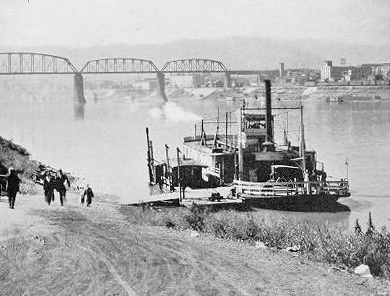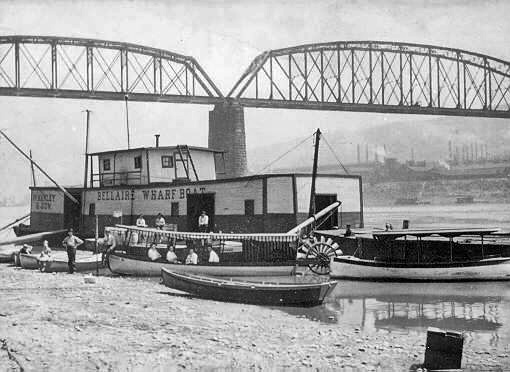A Ferryboat Ride to the Other Side
Many of us cross the Ohio River daily, giving hardly a thought if any, to the crossing or to the bridge we used. However, to cross the river two-hundred years ago was something one had to plan and ferryboats were the means one used.
Crossing the river on a ferry was costly and it took much time allowing for the wait in line and the time taken in the crossing itself. Not only that, but the crossing could be very dangerous. Could you imagine making the crossing in high water or in winter conditions with ice flows bumping the boat?
Martins Ferry is the oldest settlement in Ohio (1779) and if it weren’t for ferryboats, the town may have been known as Hoglin’s Town or Hoglinstown, Mercer’s or Mercertown, maybe Jefferson, Martinsville or as in 1785, Norristown for Charles Norris (note 1), who knows?
Ferryboats as early as the 1780s were serving Martins Ferry. The first ferry service, for which the city of Martins Ferry was eventually named, was started between 1785 and 1789 by Ebenezer and Jonathan Zane on land they owned on the south side of the old County Road, later Jefferson Street, Martins Ferry. This ferry operated from the foot of Jefferson Street to First Street, Wheeling, Virginia, at a point very even with the north tip of Wheeling Island. A ferry house and tavern stood at the foot of Jefferson Street. Hearty men push-poled these early ferryboats across the river, it being very shallow north of the Island.
Capt. Absalom Martin received a land grant in 1788 and settled upon his grant of six hundred-forty acres (one section) in 1789 where he built a log cabin very near the Ohio River just north of present Hanover Street.
In 1789, lands in the Northwest Territory were opened to white occupation and migration was soon in full swing. Stages arrived and departed Wheeling twice a week carrying passengers and U.S. Mail. Stage lines from the east were transporting people to and from Wheeling over the old portage road, the National Road did not open until 1818. At Wheeling, one could board an Ohio River packet boat (a large well-appointed keelboat) for a trip to Pittsburgh or Cincinnati.
| On the first Sister Island, just below the Ohio River’s Pike Island Locks and Dam an amusement park operated for several years beginning in 1905. The ferryboat Emily ran excursion trips to the park from Warwood and Martins Ferry in 1905 and 1906 and from Bellaire in 1913. The stern-wheel packet Avalon renamed Ohio ran excursions to the park out of Martins Ferry, Bellaire, and Wheeling. At times, a pontoon bridge crossed the Ohio River to the Sister Island at North Twenty-Fourth Street, Warwood. The park had a roller coaster, a merry-go-round, miniature trains, a skating rink, dance floor, circle swings, a shooting gallery, slides and two camels. The amusement park was destroyed by fire after 1914 (4). Absalom Martin had laid out a town in 1795 and called it Jefferson, but failing to secure the town as the Belmont County seat, the planned town was vacated, the lots were sold and repurchased by him. Absalom married Catherine Zane, daughter of Ebenezer Zane of Wheeling, Virginia. Following Catherine’s death, he married Minerva Zane, the daughter of Isaac Zane. Ebenezer Martin, Absalom Martin’s son, founder of todays’ Martins Ferry, was born November 9, 1791 at the site of his father’s original log cabin. Absalom died at his farm in January of 1802 and young Ebenezer inherited and took over the farm and ferry business (5). |
In 1809, Ebenezer Martin married Hannah McLaughlin, a daughter of Elizabeth (Betty Zane) McLaughlin. By 1810, both the Absalom Martin and Zane ferrys came into the possession of Ebenezer, the Zane ferry through his mother’s interest in Col. Ebenezer Zane’s estate.
From the late 1700s into the early 1800s, the Martin and Zane ferrys did a booming business. Ohio farms to the west of the river were producing crops in excess of what could be consumed locally. Produce was delivered to ferry landings daily and ‘Drovers’ were moving large herds of cattle, sheep and hogs, flocks of geese and turkeys to these ferry landings for transport down-river by flatboats, keelboats and barges. Holding pens were constructed on either side of the river to corral these large herds waiting to cross the river, or waiting for passage down-river. Crossing the river at Wheeling was not practical for herds of livestock, as it required boarding a ferry at Canton, Bridgeport, crossing the west channel to the Island, crossing the Island and boarding another ferry to cross the river to Wheeling (6).
Ebenezer laid out the town of Martinsville in 1835, which was changed to Martin’s Ferry in 1845. The apostrophe was eventually dropped, and it is now known as Martins Ferry, Ohio (7). Ebenezer died January 15, 1876.
At Wheeling, Zane inaugurated the west, back channel “Current” ferry (also known to some as a “Lea-board” ferry) in 1796, operated by his son-in-law, Elijah Woods (8). Zane had placed this ferry in service in anticipation of the opening of “Zane’s Trace”. The United States Congress granted Colonel Ebenezer Zane a contract on May 17, 1796 to establish a path between Wheeling, Virginia and Limestone, (Maysville) Kentucky and the requirements imposed in the contract would have Zane complete the path by January 1, 1897. Colonel Zane was also required to operate ferries across the Muskingum, Hocking and Scioto Rivers. Colonel Zane had his “Zane’s Trace” open in 1797 (9). This ferry operated from the Island to Bridgeport or Canton until Zane’s covered bridge was completed in 1837. Walker Hunter officiated as Zanes ferryman (10).
The Zanes had a second (east channel) Wheeling-Wheeling Island ferry, a four-horse ‘team-boat’ ferry in operation by 1807. A four-horse ferry at Wheeling was noted by a traveler in 1832.
Capt. Inglebright was operating the stern-wheel packet City of Chartiers from Jefferson Street, Martins Ferry to First Street Wheeling in 1889 and he was running the ferry Conveyor built at Middleport, Ohio from 1898 to 1905 from Martins Ferry to First Street in Wheeling and to Wheeling’s wharf. The Aetnaville Bridge built in 1891, cut into Inglebright’s ferry business considerably. A 1900 W.C. Brown photograph of the ferryboat Conveyor taken at the Wheeling wharf has written on the margin, “This was the most direct route to Martins Ferry.”
Judge John S. Cochran mentions in his 1907 book, “Bonnie Belmont” that his mother hauled produce to market leaving her home on Buckeye Run at 1:30 a.m. taking the ferry to First Street, Wheeling setting up at 3:30 a.m. at Wheeling’s First Ward Market at Tenth Street. History records, this same trip was earlier taken by Betty Zane McLaughlin with produce from her Westlawn Edition farm off Ferry View.
Henry N. Warwood for whom the town of Warwood, West Virginia was named, in 1854 was a tool manufacturer in Martins Ferry, Ohio. In 1892, he moved the business to Wheeling and in 1905, Warwood Tool Co. moved to Warwood at North Nineteenth Street. Many generations of Martins Ferry families had remained working with the company and thus the following took place. Luther Hoskinson (14) began running a motorized passenger ferryboat ferrying passengers, mostly women finishing their shifts at Warwood Tool and the ‘Can Factory’ over to a floating dock near North Nineteenth Street (15). Hoskinson was making the same trip that Absalom Martin originally made from the beach landing at Center Street. This service was later taken over by the Cruise family who lived on an Ohio shore houseboat.
W. Scott Heatherington of Bellaire, Ohio made runs with his towboat Eliza from Benson’s Landing in 1896. Albert C. Polley was making this run to Wheeling from 1914-1916 with the stern-wheel ferry Albert built at Dravosburg, Pennsylvania. In 1916, Polley traded Albert for the ferry Buckeye, which he sold in 1920. Capt. Scott Heatherington piloted the Buckeye for Polley from 1916 to 1920.
In 1889, Mr. R.M. Gilleland was president of the Benwood & Wheeling Ferry Co., which he ran out of Bellaire, Ohio into the 1920s. This ferry service ran two ferry boats daily from Bellaire to the Forty Third Street, Bloch Bros. Tobacco dock, Wheeling and to Seventh or Ferry Street, Benwood, West Virginia (18). Gilleland had the stern-wheel ferry Charon built at the Axton yard, West Brownsville, Pennsylvania in 1889 for his Ferry Co., which he ran into 1928. In 1911, Gilleland was running the 1895 ferry Ironton built at Levanna, Ohio. In November 1923, Ironton was involved in a ruinous fire. She was rebuilt at Moundsville, West Virginia where her name was changed to Ruth Ann, March 7, 1924. Ruth Ann served Wheeling, Benwood-Bellaire from 1924-1928.
The stern-wheel ferry Emily was built by the Howard boat yard at Jeffersonville, Indiana in 1891. William Manley and C.W. Dickens of Bellaire bought the ferryboat Emily in 1913 and ran her from the Bellaire wharfboat to Benwood into the early 1920s. Emily had earlier ferried vacationers to the Sister Island Amusement Park.
| This photo of the Wm. Manley & Son Bellaire Wharfboat shows the last people ferryboats running out of Bellaire. They were the Hazel and Gertrude passenger ferryboats powered by Fairbanks-Morse gasoline engines. These boats could safely ferry a dozen people over to Benwood and or to the Forty-Third Street, Wheeling landing. Many Bloch Bros. workers took this ferry daily. Bellaire’s ferry service ended when the Bellaire Toll Bridge was built in 1926. These same type motorized ferryboats were running from Martins Ferry to Warwood in the 1920s -1930s. We have read of ferryboats ferrying people, horses, and livestock, produce, etc. but, what about this… Starting in 1855, ferryboats were used by the Baltimore and Ohio and Central Ohio Railroad to transfer their railcars from Benwood, Virginia to Bellaire, Ohio. Early in 1855, the B&O R.R. placed an order with the Wilson & Dunlevy boat yard in Wheeling, Virginia for two specialized barges, 21 feet by 100 feet, heavily reinforced, and equipped with rails to transfer railcars from Benwood, Virginia to Bellaire, Ohio. The B&O R.R. ferried railcars from Benwood to Bellaire from 1855 to 1871 and beyond. The packet Brown Dick ran transfer barges for the B&O from 1855 to 1862. The packet Adelia, with Capt. G.W. Graham in the summer of 1855 assisted Brown Dick making five transfer trips a day from Benwood to Bellaire. The B&O towboat Wm. H. Harrison replaced Brown Dick and ran transfer trips from Benwood to Bellaire from 1862 until the Great Stone Viaduct Bridge was opened in 1871. |
Endnotes
1. Source: Brant & Fuller, History of the Upper Ohio Valley, 1890, Vol. II Pg. 763
2. Source: Tanks, Annie C., Annie Tanks’ Martins Ferry A History of Martins Ferry, Ohio to the 1920s, Pg. 33
3. Source: Bissett, Mabel H., Jones, Bertha C., Bentfield, Ernest St. C., Warwood A History 1669-1975, 1993, Pg. 12
4. Source: Ibid. Pg. 53
5. Source: Tanks, Annie C., Annie Tanks’ Martins Ferry A History of Martins Ferry, Ohio to the 1920s, 2006, Pg. 36
6. Source: Ibid. Pg. 41
7. Source: Brant & Fuller, History of the Upper Ohio Valley, 1890, Vol. II Pg. 547
8. Source: Ibid. Pg. 760
9. Source: Schneider, Norris F. and Stebbins, Clair C., Zane’s Trace The First Road In Ohio, 1973, Pg. 8
10. Source: J.H. Newton, G.G. Nichols and A.G. Sprankle, History of the Pan-Handle, 1879, Pg. 192, 194
11. Source: Bowman, John, Wheeling The Birthplace Of The American Steamboat, 2008, Pg. 14
12. Source: Early Settlement of Martins Ferry, From the Evening Times, “The Ferry Landing”, Winter 2009, Martins Ferry Area Historical Society.
13. Source: Caldwell, John Alexander, History of Belmont and Jefferson Counties, Ohio, and Incidentally Historical Collections Pertaining to Border Warfare and the Early Settlement of the Adjacent Portion of the Ohio Valley, 1880, Published by the Historical Publishing Co. Wheeling, W. Va.
14. Source: Tanks, Annie C., A Town of Grandeur: Essays on the History of Martins Ferry, Ohio, 2nd Edition Martins Ferry Area Historical Society, Inc. 1987, 1995 Pg. 103
15. Source: Shemenski, Andrew, Bulltown: A Great Place To Grow Up, 1996, Pg. 14
16. Source: Bowman, John, Wheeling The Birthplace Of The American Steamboat, 2008
17. Source: Ibid.
18. Source: J.H. Newton, G.G. Nichols and A.G. Sprankle, History of the Pan-Handle, 1879, Pg. 196
19. Source: Great Stone Viaduct Historical Education Society




